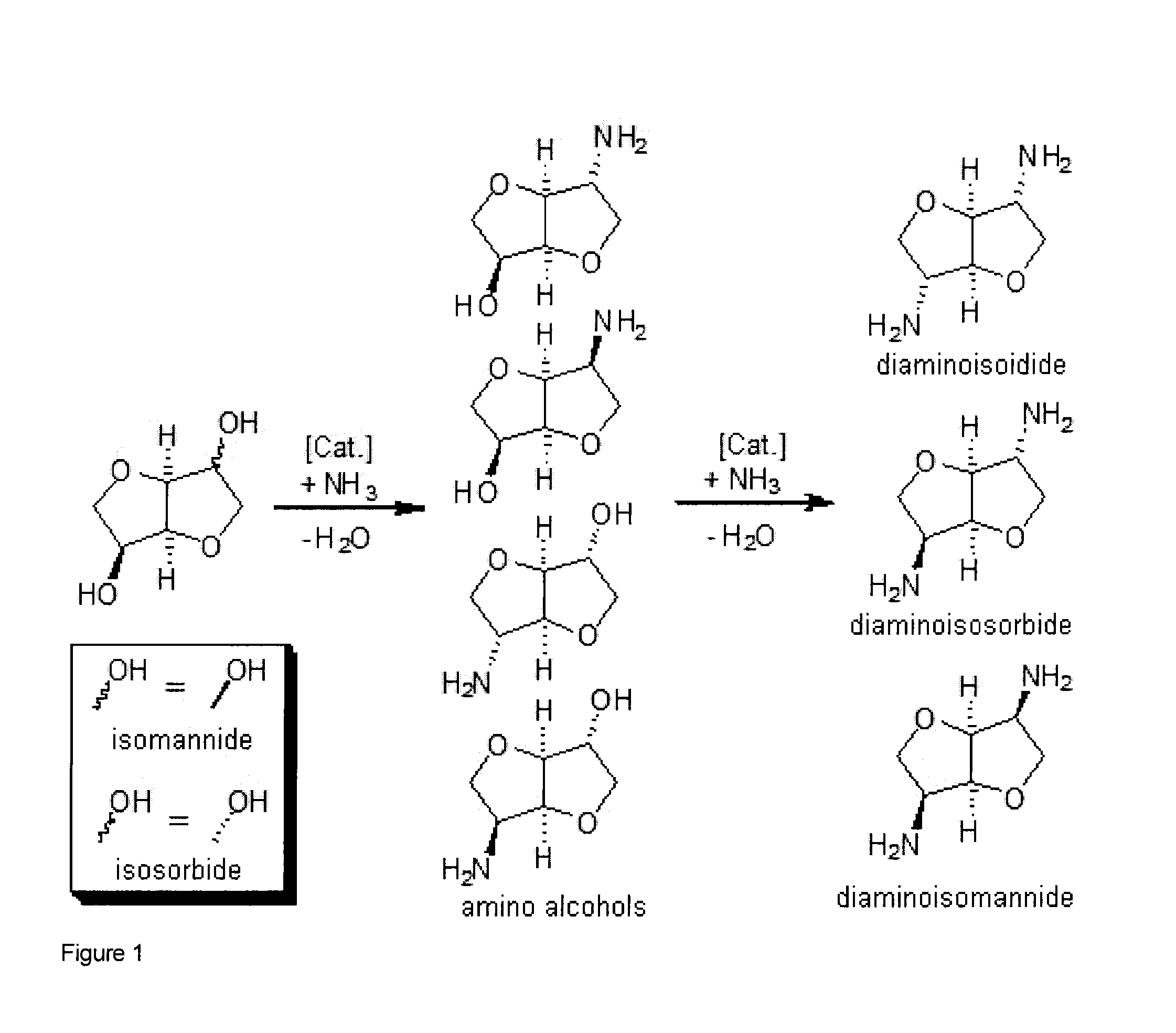Process for the direct amination of secondary alcohols with ammonia to give primary amines
a technology of ammonia and secondary alcohol, which is applied in the preparation of amino compounds, organic chemistry, chemistry apparatus and processes, etc., can solve the problems of time-consuming and costly two-stage mode of operation with isolation of carbonyl compounds, heterogeneous catalysis of gas-phase processes,
- Summary
- Abstract
- Description
- Claims
- Application Information
AI Technical Summary
Benefits of technology
Problems solved by technology
Method used
Image
Examples
example 1
Direct Single-Stage Amination of Isomannide by Means of Ammonia Over Heterogeneous Catalysts, Comparative Example
[0075]1.45 g of isomannide (10 mmol) and 2.78 g of a catalyst based on Ni / Al2O3 are placed in a high-pressure reactor provided with propeller stirrer and internal cooling coil and flushed with nitrogen at room temperature in the closed and gastight reactor. 250 ml of liquid ammonia (10 mol) are then metered in over a period of 25 minutes and the reaction mixture is heated in stages firstly to 150° C. (140 bar), then to 185° C. (260 bar). After a reaction time of 90 minutes, the reactor is cooled, vented, the reaction mixture is taken up in ethanol and filtered. No conversion of isomannide can be observed when using a catalyst based on elemental nickel.
example 2
Direct Single-Stage Amination of Isomannide by Means of Ammonia Over Coordination Compounds of Monodentate Ligands (Vliq / Vgas=0.35, Example According to the Invention)
[0076]Under an argon atmosphere, 1.461 g (10 mmol) of isomannide, 0.1 mmol of [Ru(p-cym)Cl2]2 / K2CO3 and 25 ml of 2-methyl-2-butanol as solvent are placed in the glass liner of a 100 ml Hastelloy autoclave. The autoclave is closed, pressurized with 20 bar of argon and vented three times and again pressurized with 15 bar of argon. 235.2 mmol of ammonia are then introduced into the autoclave (overall Vliq / Vgas=0.35). The reaction mixture is stirred for 10 minutes at room temperature (600 rpm), subsequently heated while stirring to 140° C. and maintained at this temperature for 24 hours. After cooling to room temperature, careful depressurization of the mixture and pressurization with 20 bar of argon three times with subsequent venting, the autoclave is opened, the reaction mixture filtered through kieselguhr and the filtr...
example 3
Direct Single-Stage Amination of 2-dodecanol by Means of Ammonia Over a Ruthenium-Pincer Complex (Vliq / Vgas=0.3, Accouding to the Invention)
[0077]Under an argon atmosphere, 1.863 g (10 mmol) of 2-dodecanol, 0.030 g (0.05 mmol) of carbonylchlorohydrido[4,5-(di-i-propylphosphinomethylacridino)ruthenium(II)] as catalyst and 25 ml of 2-methyl-2-butanol as solvent are placed in the glass liner of a 100 ml Hastelloy autoclave. The autoclave is closed, pressurized with 20 bar of argon and vented three times and again pressurized with 15 bar of argon. 2 g (117.6 mmol) of liquid ammonia are then introduced into the autoclave (overall Vliq / Vgas=0.3). The reaction mixture is stirred for 10 minutes at room temperature (600 rpm), subsequently heated while stirring to an internal temperature of 170° C. and maintained at this temperature for 48 hours. After cooling to room temperature, careful depressurization of the mixture and pressurization with 20 bar of argon three times with subsequent venti...
PUM
| Property | Measurement | Unit |
|---|---|---|
| Temperature | aaaaa | aaaaa |
| Pressure | aaaaa | aaaaa |
| Volume | aaaaa | aaaaa |
Abstract
Description
Claims
Application Information
 Login to View More
Login to View More - R&D
- Intellectual Property
- Life Sciences
- Materials
- Tech Scout
- Unparalleled Data Quality
- Higher Quality Content
- 60% Fewer Hallucinations
Browse by: Latest US Patents, China's latest patents, Technical Efficacy Thesaurus, Application Domain, Technology Topic, Popular Technical Reports.
© 2025 PatSnap. All rights reserved.Legal|Privacy policy|Modern Slavery Act Transparency Statement|Sitemap|About US| Contact US: help@patsnap.com



